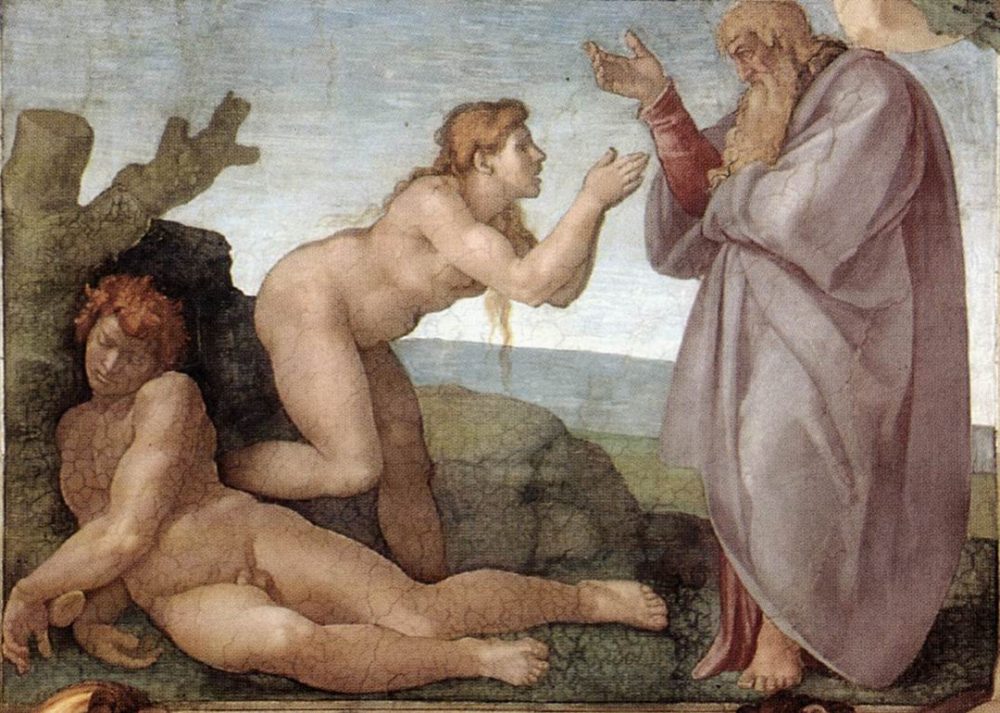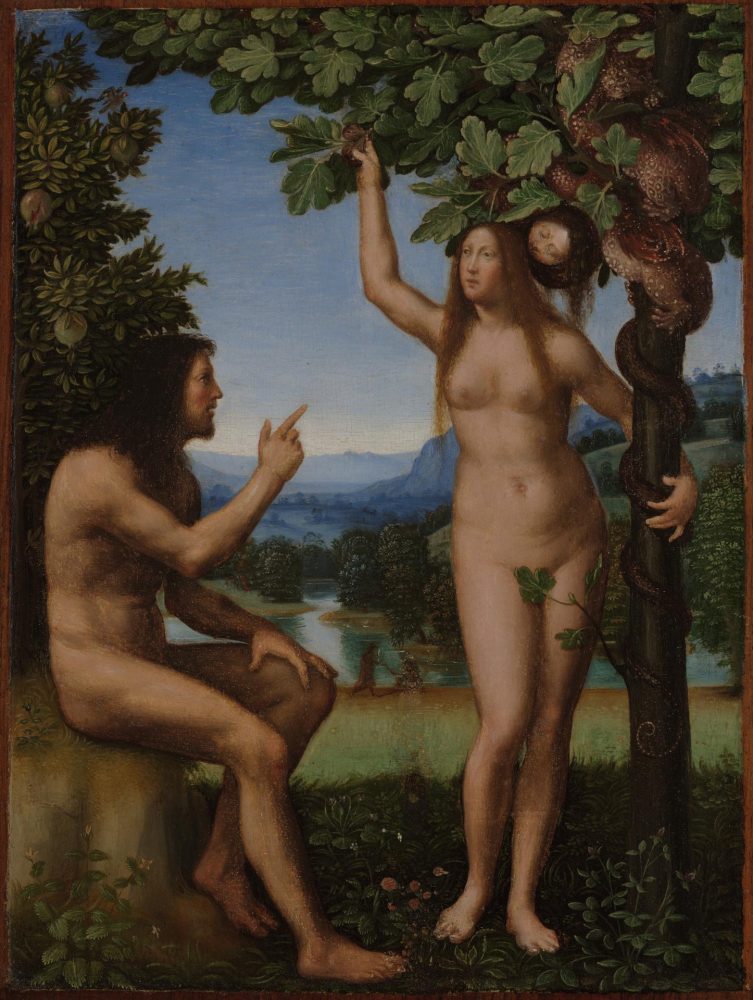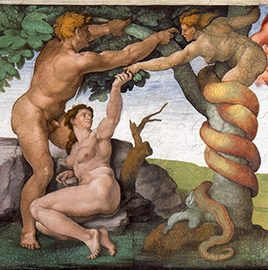Objects
Michelangelo’s “Temptation” – Debunking the Biblical Myth
Lily Kruse

Fig 1. Michelangelo, The Creation of Adam, 1508-1512, Sistine Chapel.
As one of Michelangelo’s penultimate works, the frescoes on the Sistine Ceiling have served as a source of inspiration for countless artists and movements throughout modern art history; they are also an abundant source of inquiry for scholars and art historians. Commissioned by Pope Julius II in 1508 and completed in 1512, the frescoes’ subject matter varies widely, but the different scenes generally center around stories and figures from the Old Testament and are situated within Michelangelo’s innovative and highly successful use of fictive architecture. The use of fictive architecture frames the scenes and makes them into an awesome and dramatic presentation, standing as a testament to Michelangelo’s mastery of drawing—more specifically designo—in his seamless application of perspective and foreshortening as he adjusted the designs and accounted for the curvatures of the ceiling. While the impossibly impressive quality of the design and execution of the frescoes is widely agreed upon by both artists and art historians, the nature and origin of the scenes depicted have not been readily accepted, notwithstanding centuries of investigation.
Although the entirety of the Sistine Ceiling is renowned for its beauty and as an astonishing artistic achievement, arguably the most infamous scenes are those of The Creation of Adam, The Creation of Eve, and The Temptation and Expulsion from Paradise (Fig. 1-3). Like the rest of the scenes on the ceiling, these scenes find their supposed origins in the Old Testament. However, when observed through the lens of theology and in acknowledging the history of the Bible as a religious text, simply stating that Michelangelo found his inspiration in the chapters of the Old Testament for the depiction of these scenes is inaccurate and insufficient. In particular, there is ample scholarship surrounding The Temptation and Expulsion from Paradise. A brief study of both earlier and contemporary artistic depictions of the same story from Genesis lends a satisfactory introduction to the query most art historians are posed with when faced with Michelangelo’s 1512 fresco: why does this version appear to be at odds with the story we know? For the most part, with a few choice exceptions, artistic renditions of the story of Adam and Eve in the Garden of Eden portray it as told in the first two chapters of Genesis. Eve acts in the critical role as the perpetrator of original sin: falling victim to the conniving serpent, eating the forbidden fruit, and covering herself now that she has become aware of her nakedness. Conventional images of the story can be summarized in Florentine artist Mariotto Albertinelli’s 1509-13 portrayal of the scene, where Eve is engaging with the tree of knowledge, with one arm wrapped around the trunk in a manner that mirrors the twisting tail of the serpent, and the other reaching in the branches to grab its fruit (Fig. 4). Adam, in this as in many other depictions, takes the passive role—who rather than engaging with the tree is engaging with his wife—whose newfound knowledge Albertinelli has slyly alluded to by placing a branch that seems by happenstance to cover Eve’s private area.

Fig. 2 Michelangelo, The Creation of Eve, 1508-1512, Sistine Chapel.
In Michelangelo’s illustration, however, the dynamic between Adam and Eve not only appears to be reversed, with Adam taking on the active role, but the serpent appears in a way that is entirely uncommon for a sixteenth-century Florentine artist: as a wholly embodied—albeit long, with looping tendrils in lieu of feet—woman. Even more curious, the woman playing the role of the serpent who introduced sin into paradise bears quite a few similarities to Adam. Many art historians have noted these salient deviations from the original script as written in Genesis, and a wide range of theories have been proposed as the more likely origin of Michelangelo’s strange scene. A veritable explanation is that Michelangelo depicts an earlier version of the story, one that is much unlike the one told in Genesis. Rather than illustrating the later edition, some scholars suggest that Michelangelo is picturing the story as described in the Zohar, one of the literary foundations of the ancient Jewish tradition of mysticism known as Kabbalah.1 According to traditional Jewish belief, the Zohar acts as an interpretive text of the Torah. Nathan Wolski, a scholar dedicated to the study of the thirteenth-century kabbalistic work, describes it as “a group of wandering mystics…who converse with each other and interpret the Torah while traveling through the Holy Land.”2 Interestingly, and unexpected for many modern admirers of Michelangelo’s frescoes who are under the impression that the work is undoubtedly Catholic, a visual reading of The Temptation and Expulsion adheres more closely to the story told in the Zohar than in Genesis.
To explain the discrepancies between these two religious texts and the image that Michelangelo has supplied, it is beneficial to first begin with the creation of man. Genesis 1:27-28 reads: “So God created man in his own image, in the image of God created He him; male and female created He them. And God blessed them, and God said unto them, Be fruitful, and multiply, and replenish the earth.” Important to note in these two verses is the mention of “male and female” and that this original male and female pair were meant to “be fruitful, and multiply.” A literal translation of these two verses could be read as God originally created a man and woman equally, both in God’s own image, with the purpose of reproducing and “replenish(ing) the earth.” However, as Genesis continues, there is no further mention of a female counterpart to the man created in God’s image. Instead, the story continues to the sixth day, when Adam looked upon God and asked for help. God obliged, creating Eve from Adam’s rib—making woman from man—to assist men in their duties. In contrast to this series of events, the story told in the Zohar is much different. Where Genesis deviates from the origins of man and woman being made equally in the image of God, the Zohar remains consistent. This original male and female coupling were split from one androgyne, separated into two beings: one man and one woman, known as Adam and Lilith.3 As the story goes, Lilith became frustrated that as Adam’s equal, her destiny was to lie beneath him during intercourse, and through an incantation, she left paradise and met Samael. Samael is the personification of Satan in the Zohar, and the scene where Samael and Lilith return to paradise and encounter Eve reads:
“It was Samael, and he appeared on a serpent (Lilith), for the ideal form of the serpent is Satan. We have learnt that at that moment Samael came down from heaven riding on this serpent, and all creatures saw his form and fled before him. They then entered into conversation with the woman (Eve) and the two brought death into the world.”

Fig. 3 Michelangelo, The Temptation and Expulsion from Paradise, 1508-1512, Sistine Chapel.
In searching for a literary origin of the story Michelangelo illustrates in his Temptation and Expulsion, it is in the Zohar that we find the most likely source.
This interpretation of Michelangelo’s fresco, as a rendition of the medieval kabbalistic text as opposed to the Biblical telling, is supported by a visual reading of the image. Firstly, it is the embodiment of the serpent, and not just that Michelangelo has given it a body, but he has made the serpent a woman. Moreover, this woman bears an uncanny likeness to Adam. Lilith would have resembled him in the Zohar, having split from the same being, and Michelangelo reiterates this likeness in more than one way.4 Both Adam and the female personification of the serpent (Lilith) have blonde hair, both faces physically are quite similar, are shown in profile and mirror each other almost exactly, and their poses are reciprocal models of one another, both inadvertently pointing in the other’s direction (Fig. 5). With these physical similarities and the fact that in the Zohar it is Lilith who takes the body of a serpent and comes to Eden to speak with Eve, it is a safe conclusion that Michelangelo’s serpent is Lilith. Further support for a kabbalistic reading of this fresco lies in Adam and Eve’s figuration within the scene, with Adam taking a more active role while Eve reclines, lazily engaging with the actions taking place. Adam’s pose is highly dynamic, half-crouched as if he has just jumped out of his seated position on the rock where Eve still leans, stretching his arms out to reach the tree and its fruit. This reversal of roles, Adam taking the lead while Eve resorts to a passive role, is also supported by the literature of the Zohar. It is actually Adam who commits the first sinful act by breaking the branch of the tree, or rather enacting “the separation of the kingdom from the other branches.”5 Michelangelo has also hinted at this treacherous act in his fresco, with Adam’s left hand tightly gripped around a branch of the tree to steady himself as he reaches for fruit with his right.

Fig. 4 Mariotto Albertinelli, The Temptation of Adam and Eve, 1509-1513, Yale University Art Gallery.
Although centuries of history and popular belief tells us that Michelangelo’s frescoes on the Sistine Ceiling are Catholic in their origins, upon further inspection it is quite clear that Michelangelo may have been reading a different book: the Zohar. A closer review of history lends even more credibility to Michelangelo’s mishap in the library. From 1490 to 1492, Michelangelo lived in the gardens of Lorenzo de Medici, where he not only practiced sculpture but also gained exposure to humanist studies and its scholars. Among those humanists was Giovanni Pico della Mirandola, who was coined by contemporaries as “the first Christian kabbalist.”6

Fig. 5 Detail, Michelangelo, The Temptation and Expulsion from Paradise, 1508-1512, Sistine Chapel.
Unlike many of the popularly known humanists of the fifteenth and sixteenth centuries who studied and translated Greek and Latin texts, Mirandola focused his attention on ancient Hebrew texts, such as the Zohar. Although no historical records solidify Michelangelo’s knowledge of Mirandola and his works, it is safe to assume that they were aware of each other and that Michelangelo would have had access to Mirandola’s translation of the Zohar. Furthermore, Michelangelo’s fresco of the scene of the Temptation lends validity to his probable knowledge of Mirandola, as the visual translation Michelangelo has provided us on the ceiling of the Sistine Chapel is an almost perfect illustration of the story as told in the Zohar and not the version told in the Bible.
Lily Kruse is a second-year student in the History of Design and Curatorial Studies MA Program offered jointly by Parsons School of Design and Cooper Hewitt, Smithsonian Design Museum. From Franklin, Tennessee, and a graduate of the University of Mississippi, her recent work focuses on the use of fine art and visual culture as a pedagogical tool of Catholicism – specifically in the works of Michelangelo and other sixteenth-century artists who created works of art commissioned by the church. Lily is most interested in the sociological impact of art when used in a religious context.
Notes
- Jane Schuyler, “Michelangelo’s Serpent with Two Tails,” Notes in the History of Art 9, no. 2 (Winter 1990), 24.
- Nathan Wolski, A Journey into the Zohar: An Introduction to the Book of Radiance, New York: State University of New York Press, 2010, 2.
- Jane Schuyler, “Michelangelo’s Serpent with Two Tails,” 27.
- Jeffrey M. Hoffeld, “Adam’s Two Wives,” The Metropolitan Museum of Art Bulletin 26, no. 10 (Summer 1968), 434.
- Jane Schuyler, “Michelangelo’s Serpent with Two Tails,” 27.
- Jane Schuyler, “Michelangelo’s Serpent with Two Tails,” 28.
